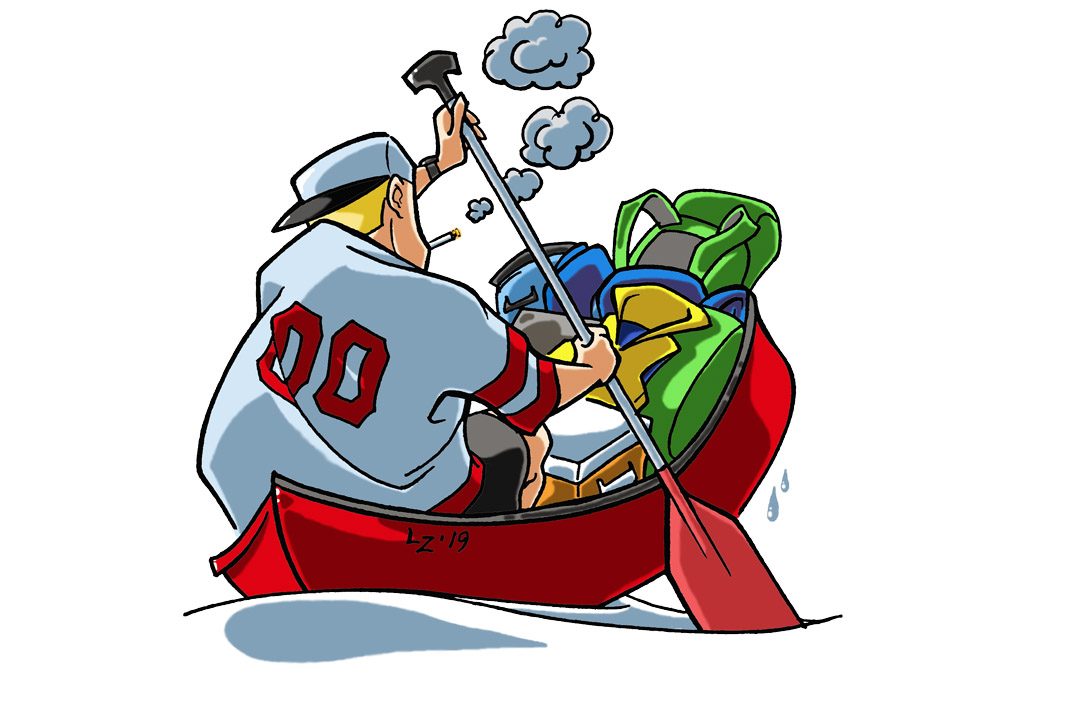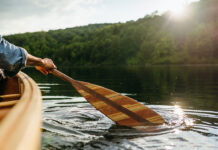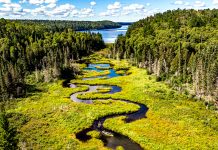Canoe tripping skills aren’t learned quickly, but increasingly many paddlers I see don’t have the patience or even the desire to take the time to learn.
Just as watching YouTube videos on how to fix a toilet doesn’t make you a professional plumber, watching clips on how to light a fire, erect a tarp or perfect the J-stroke do not make you a master of the elements. Practice makes perfect.
Safety third
Provincial and national parks do little to ensure campers are sufficiently skilled before they head into the interior, treating it as an issue of personal responsibility.
Usually, park employees just hand over a permit and wave the campers on their merry way.
This wasn’t always the case. I bet there are a few longtime Ontario Parks campers who will remember the classic Crickets Make Me Nervous. It was a canoe tripping safety film shown at park amphitheaters in the 1970s. I haven’t seen anything like it in years.
I like to think most paddlers take their safety seriously, but I know there are some who don’t because I’ve met them. People are setting out without life jackets, an inch of freeboard or a clue.
Governing bodies like Paddle Canada and the ACA do an excellent job of training people to go on canoe and kayak trips safely, however, training is geared towards those motivated to learn the skills and play safe.
I’ve heard the odd rumble about mandatory skills tests for backcountry paddlers, or at least optional educational programs for the inexperienced.
What are the unprepared paddlers statistics?
Canada has the BoatSmart program, which requires anyone who wants to operate a motorboat to take a course on skills and safety and pass a test—for $49.95. Passing gets you a boating license.
Some argue the license system is just another cash grab, but boating fatalities have fallen by 32 percent since the system was introduced. Coincidence?
According to the United States Coast Guard (USCG), in 2017 there were 138 deaths involving canoes and kayaks. Of those cases, 88 percent of victims drowned. Of those drowning victims, more than two-thirds were not wearing life jackets.
Looking at the USCG’s boating fatalities more generally, 81 percent of deaths occur on boats where the operator did not receive boating safety instruction.
Only 14 percent percent of deaths occurred on vessels where the operator had received a nationally-approved boating safety education certificate.
Alcohol was also listed as the leading factor in 19 percent of all boating deaths.
Don’t be a stupid paddler, stupid
Through my local news, I hear about a handful of paddling deaths each year, usually due to drowning or cold-water immersion. I’m sad and frustrated each time I hear about another outdoor mishap because if the stats are anything to go by, these tragedies are often avoidable.
And the more accidents, the more likely regulations will eventually be forced on all of us because of a few who do not play safely. How fair is that?
In my presentations and books, I stress the importance of life jackets and wilderness safety. Often, what I really want to say to people is what my mother, who has a strong Scottish disposition, always told me before heading out into the woods: “Dinnea be stupid!”
She’d blurt it out every time I headed out on a trip, and she still offers this sage advice.
Wear a life jacket, wait until the wind dies down on a lake before crossing, bring a first-aid kit and know how to use it. Just dinnea be stupid.
Columnist Kevin Callan recently celebrated the release of his 18th book, Once Around Algonquin: An Epic Canoe Journey, which spins tales from a lengthy trip where he witnessed a lot of questionable behavior.
We turned the photo Kevin submitted for this story into an illustration to protect the guilty.










Excellent article! While I’m not a paddler yet, I am looking into kayaks I can pedal. Still, as you’ve noted Safety should be Job #1 whenever you’re headed out onto new ventures. (i.e. Novice paddlers) The “Unprepared Paddlers Statistics” were great, thanks for sharing and trying to help educate others about such issues.
I live in the Ozarks…Ozark National Scenic Rivers. We see literally many hundreds of tourists who come here never having sat in a canoe/kayak, and not even knowing how to hokd a paddle. Our group ends up “rescuing” these people almost every time we hit the river.
However, if ONSR were to require every paddler to be trained and certified, the outcry would be deafening. This is a National Park which means that anyone with the $$$ to rent a boat can get on the water.
While I appreciate your premise, there are times and places where training is not a viable option. In those cases, it’s up to folks like you and me to suffer the fools, and do our best to keep them alive and relatively unscathed.
Thanks for a great article.
Good points but in addition to those mentioned is the overriding laxity of much media in trivializing skills and offering tips that merely touch on deeper issues, the “why” behind the technique or the exceptions to what can happen. Seems everyone wants to be an ‘expert’ and spew tidbits of information that is essentially correct but fail to put it all in perspective. Seems everything using a double paddle is a “kayak” these days yet some of the techniques touted as being useful fail to expand the seriousness of the situations paddlers get into. There is rarely only one way to mitigate a dangerous situation yet the paddling media seems content on throwing out a simple solution and letting it go at that, giving the reader a false sense of competence and awareness of needing to know more. Good to see that safety is always a main topic, but let’s put a little more meat on that skeleton when we are offering safety pointers.
Yes – I am concerned about the ill advised paddlers who venture onto the water unprepared and sometimes pay with their lives, but how bad really is this problem ? The only statistic we see published is the raw number of fatalities, like the 137 deaths in 2017. But is that increase or decrease in the percentage of actual paddling population?? Paddling sports are becoming more popular every year, so more folks are paddling, so it is likely we may see an increase in fatalities, but in realty, the actual rate is probably going down due to the efforts of paddlesport organizations. I fear over-regulation will hinder the popularity of a sport that enjoyed by more of the population every year. Should we require training and a permit to cross the street because a lot of people die when they don’t look both ways or are texting? Manufacturers and retailers should play a bigger role in safety education, not the government.
Do the lessons include a kayak?
I enjoyed reading your piece, Kevin. It’s hard to argue with your premise. But we cannot legislate good jugement nor eliminate the risks. And as cruel as it sounds, a “natural selection” assists in ridding the planet of “idiots”. “Shit happens no matter how prepared one may be!
I wouldn’t say that trying to learn to paddle from watching YouTube videos is inappropriate or useless; but I would agree that it is less than adequate. I like to remain open to all manners of learning, and while not all instructional videos are created equal, there are some real pearls out there that help highlighting the various skills and competence needed to have fun and stay safe on the water. Video is a good medium.
The notion of reliance solely resting on wearing a life jacket is also misguided at best (in my view), and it distracts from embracing the enormously longer list of necessary skills that need to be acquired and maintained to play in cold water. It’s a no-brainer: You need to wear a life vest but that alone will not save your life. A certification in the hands of those who aren’t regularly active in the sport of paddling doesn’t do much either to insure they’ll always make it home without a hitch.
Bottom line is: Cold water sports are risky, require skills, good equipment and a ton of experience … which can only be acquired over time, by making, at times, significant mistakes and surviving. It’s a lifestyle! A learning journey to the end.
No Life Jacket, No excuse
“Your comment is awaiting moderation”? There’s too much moderation, not enough serious talk beyond the whimsy and casualness of hinting at safety and skills instead of actually teaching the “why” behind the technique. Being cute and glib might sell books but unless we replace the foo-foo factoids with serious discussions on safety, it’s all for naught…stupid is as stupid does!
Thanks Kevin. One thing that would help a lot I believe is if we started calling life-jackets life-jackets again and not PFDs. Most laypeople don’t know what PFD means, but they certainly can understand “life-jacket.” We need to reinforce the idea that their lives are their responsibility and they will need a lifejacket on at all times. It would be nice if these novices could be required to register and take an online course before being granted access to the wilderness. I’m always shocked and amazed at the risks some people take. I see them coming through a portage at 4 pm, drinking beer, without any idea where they are going to camp for the night–and there are no campsites for hours. They don’t seem interested in protecting their food from wild animals–they might as well just set a table for the bears and other critters. And personally, I would not trust a phone or GPS device as my main source of navigation. I’ll take a good topographical map and compass, thank you. CPR, first aid–each member of the team should know this too.